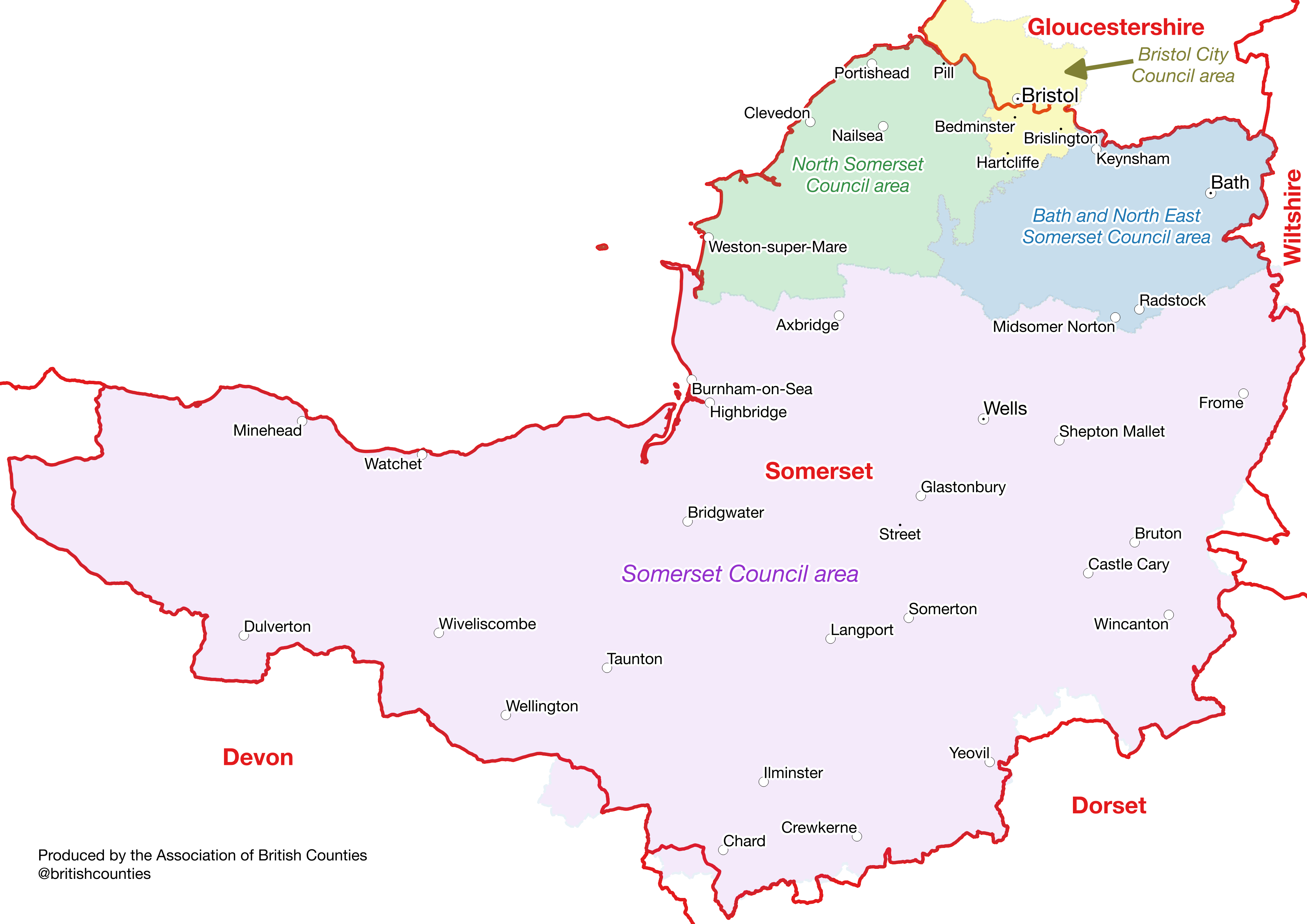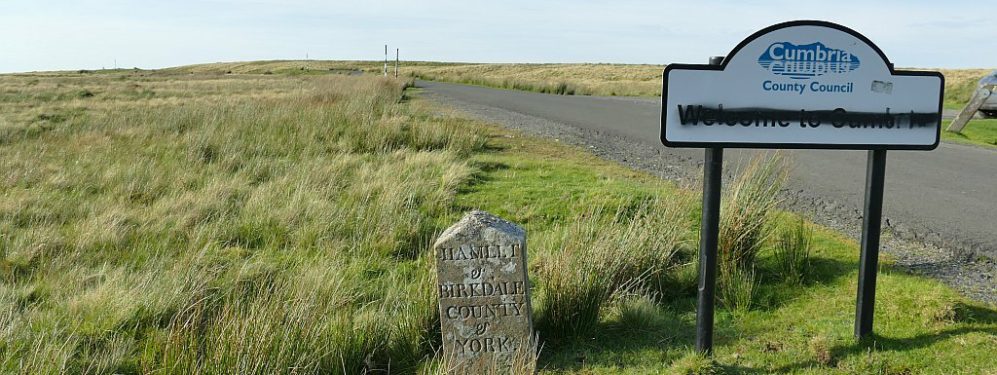From 1st April 2023, Cumbria County Council, Somerset County Council and North Yorkshire County Council and the district councils in their areas are abolished and replaced by several new unitary councils. In the context of the Association of British Counties’ aim to see local government clearly separated from the historic counties, there are some pros and some cons from the latest set of council changes.
The Association of British Counties (ABC) exists to promote the historic counties and the important part they play in our history, heritage, culture and geography. ABC has no desire to see the historic counties used as the basis for administrative areas. On the contrary, ABC believes that the major challenge to the identities of our historic counties is the continued use of the term “county” within local government parlance and the continued misuse of historic county names by local authorities. ABC advocates a set of local government terminology and local authority names which draws a clear distinction between local government and the historic counties, to the benefit of both.
The new unitary councils are:
Cumberland Council – based on the combined area of the abolished Allerdale, Carlisle and Copeland districts;
Westmorland and Furness Council – based on the combined area of the abolished Barrow, Eden and South Lakeland districts;
Somerset Council – with the same area as the abolished Somerset County Council;
North Yorkshire Council – with the same area as the abolished North Yorkshire County Council.
What are the pros and cons from ABC’s perspective?
The biggest positive is the end of Cumbria County Council. Cumbria County Council covered part of 4 historic counties: all of Cumberland and Westmorland; the Lancashire North of the Sands area of Lancashire; and the Sedbergh area of Yorkshire. Cumbria County Council consistently fostered the identity of Cumbria as a county, strongly to the detriment of the identities of these historic counties, which it made no effort to acknowledge or promote.
Another big positive is that none of the new councils is to be called ‘county council’ but simply ‘council’. This has been the case with most of the post-1990 unitary authorities created in England and is to be welcomed. ABC’s ideal is that all local government areas in England and Wales should be known as ‘council areas’, as are those in Scotland.
Less positive are the names chosen for the new councils. ABC opposes the unqualified use of an historic county name by a council unless that council area closely matches the historic county.
The area of the new Cumberland Council does at least lie entirely within the real Cumberland and it does contain 90% of the population of the historic county. However, 23% of the historic county, including Penrith and Alston, does not lie in the Cumberland Council area. ‘West Cumberland Council‘ would have been more appropriate.

The name Westmorland and Furness Council does have the advantage that it describes the greater part of the council area and is clearly not pretending to be a county or to deny the historic county identity of places within it. The council area includes the whole of Westmorland and the whole of the Furness area of Lancashire. However, 28% of the council area actually lies in Cumberland and 6% lies in the Sedbergh area of Yorkshire.
Although the new Somerset Council area does cover 81% of the area of the historic county of Somerset, only 53% of the population of the historic county lies in the new council area. The new council area does not cover the highly populated north of the historic county. Much of this remaining area is covered by the existing unitary authorities of North Somerset Council and Bath & North East Somerset Council. A small, though highly populated, area of Somerset lies in the south of the Bristol City Council area.

North Yorkshire Council is a reasonable name from ABC’s point of view, i.e. a council providing services predominantly in the north of Yorkshire.
Cumbria County Council mistaken believed that it could somehow literally become a county. Nearly fifty years of this nonsense didn’t stop its demise. The lesson for every council in this is not to seek to undermine the identities of the histories but to embrace them. They are a key part of the heritage and sense of identity of the people you serve. There are several simple but effective ways in which councils can celebrate the counties:
— Fly the appropriate county flag from public buildings
— Join in each county day celebration
— Mark historic county borders with appropriate signage
— Make use of the historic counties in promoting tourism
We might reasonably expect North Yorkshire Council to embrace Yorkshire Day, the Yorkshire flag and the Yorkshire-based tourism industry. There are also encouraging signs that the new unitary Somerset Council, despite its confusing name, is going to take a more sensitive approach to road signage.
We greatly hope that the successor authorities to Cumbria County Council take a totally different approach and embrace the historic counties of their areas. We have discussed how this could be done in more detail in relation to Westmorland and Furness Council in Celebrating the Historic Counties: Westmorland and Furness Council. These things would cost little but make a huge difference.
All local government change is helpful to ABC since it illustrates the transitory nature of administrative areas and their total unsuitability as a basis for general-purpose geography; for cultural, social and sporting activities; and as a focus of loyalty and identity. All administrative things must pass, but the historic counties endure.


7 thoughts on “Three more “county councils” abolished”
It’s exactly as I suspected unfortunately. Even as “Cumbria” is losing it’s status officially, attempts to keep it alive are to the point of obsession by businesses, residents, the whole kit & caboodle.
So ingrained is “Cumbria” mentality that it is being pushed more than ever, with the successor councils seeing themselves as being parts of “The County” being separated just for administrative purposes, and “Cumbria” being feverishly seen at the top of the pyramid.
What is astounding is that from young (understandable) but to the eldest people, people born in real Westmorland who are in their 60’s and older, similarly Cumberland and the Furness part of Lancashire, is the spell of the power of the “Cumbria” identity is as strong as ever. I boldly predicted this, and reading the shadow authorities website header pages it is patently obvious that they see themselves as sub-sets of “Cumbria”, now and moving forward and it intangibly runs through all their literature.
Royal Mail to date haven’t done anything with addresses, and in any event in the tail end of addresses, the “Cumbria” part will be re-inforced.
Pushing Michael Gove by people with influence to give “Cumbria” ceremonial county status keeps it not just flickering but very much alive.
Will BBC Radio do what it did with (say) Humberside/Cleveland by saying “broadcasting to East Yorkshire and North Lincolnshire” and “broadcasting to North Yorkshire, Teesside & County Durham” respectively by saying it is broadcasting to the ‘new’ areas?
I am sure they won’t, I expect “Cumbria” to subtlely be re-inforced.
The power of the concept of the post 1974 “Cumbria” as being something special and as though it has been around forever (they try and justify with the ancient Kingdom of Cumbria when backed in a corner, but hey, Barrow & co were never part of that particular ancient Kingdom anyway…) has worked.
Propaganda works, one only needs consider “Cumbria” in any context to see that.
The only saving grace so far that I have seen is MP Mark Jenkinson who appears to have love for Cumberland (thankfully).
How to remove the “Cumbria” mindset at all levels falls entirely on the shoulders of the successor authorities. A good start would be to take down the “Cumbria” border road signs inbound on all roads that display them. Somehow I think they will be given a pass, but I’d love to know if anyone sees them being actually replaced with new signage that does not show anything whatsoever to do with “Cumbria”…
They would have been better leaving it as it was. Sedbergh is not back in Yorkshire and Lancashire North of the sands is not back in Lancashire. Utterly ridiculous.
Absolutely not. “Cumbria” had to go as it had too much of a malign influence on people’s identities. Council areas will never match the counties, as they have been drifting apart for 134 years. All people need to realise is that council areas don’t matter. Furness IS in Lancashire and Sedbergh IS in Yorkshire. Council areas don’t define counties.
So on official documents (e.g. Passports) should/can my birth address be shown as Barrow-in-Furness, Lancashire (as it was when I was born!)?
Absolutely yes, postal counties were abolished in 1996 , and I would say that you were born whatever that place was when you were born.
Agree wholeheartedly with the editorial stance in this article and would like permission to link to it as reference material on our own site “Yorkshire Popular Front”, please Peter.
As someone born in Cumberland by definition I have always had been Cumbrian and I always shall be. I’m proud of my county, both the old one and the 1974 version and the old kingdom of Cumbria and a Cumbrian identity that at times ran from Loch Lomond to Shropshire and from the Irish Sea to the North Sea I wholeheartedly agree with the change to Cumbrian borders, they should be expanded to encompass all the areas of the Hed Ogledd.
For those who prefer the identity of Westmorland, Lancashire, Cumberland or Yorkshire, good for you, I’m from Cumberland but I still identify as a Cumbria(n) too.
Cumbria has survived for a thousand years despite domination by oppressive entities to both north and south and we always will.